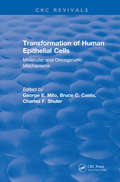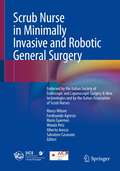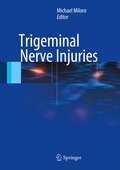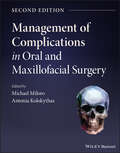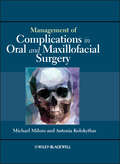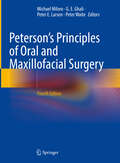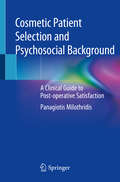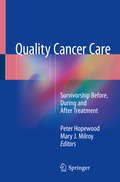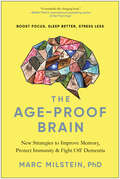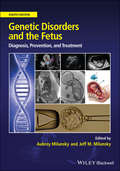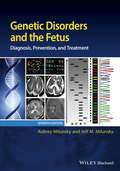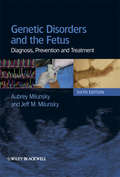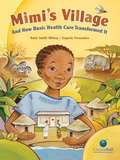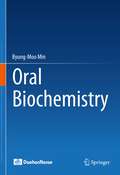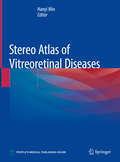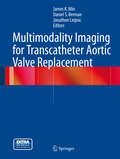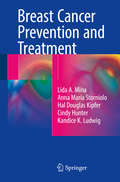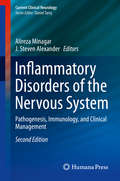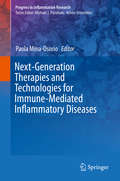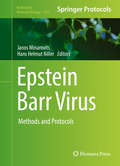- Table View
- List View
Cerebral Angiogenesis: Methods and Protocols (Methods in Molecular Biology #1135)
by Richard MilnerProviding a selection of the key techniques that are used in characterizing cerebral angiogenesis, Cerebral Angiogenesis: Methods and Protocols aims to define the cellular and molecular mechanisms underlying this important process. Divided into six parts, this detailed volume examines cerebral angiogenesis occurring in different scenarios, a variety of different models in which cerebral angiogenesis can be studied, methods to characterize and quantify angiogenic events as well as several different approaches to measure changes in cerebral blood flow, different approaches to investigate the role of specific candidate genes in cerebral angiogenesis, methods of therapeutically manipulating cerebral angiogenesis by gene delivery, and finally important approaches to examine cerebral angiogenic mechanisms in vitro. Written in the highly successful Methods in Molecular Biology series format, chapters include introductions to their specific topics, lists of the necessary materials and reagents, step-by-step, readily reproducible laboratory protocols, and tips on troubleshooting and avoiding known pitfalls. Comprehensive and decidedly practical, Cerebral Angiogenesis: Methods and Protocols should be a vital resource for all researchers, both those new to this field as well as those looking to use more specialized and sophisticated techniques to examine blood vessel growth in the brain.
Transformation of Human Epithelial Cells: Molecular and Oncogenetic Mechanisms (CRC Press Revivals)
by George E Milo Bruce C Casto Charles F ShulerThis book offers a conceptual explanation of the interrelationships that exist between the stages in the progression of initiated epithelial cells in culture compared with the diverse tissue of organs and the progression of tumors from different organ sites. The fate of the modification of adducts is discussed at the molecular level. The role that modifications in hot spots in oncogenes and supressor genes play at the molecular level and how these molecular modifications can lead to an explanation of molecular control in the formation of tumor phenotypes is also examined. Researchers in cell biology and toxicology, applied pharmacology, carcinogenesis, teratogenesis, mutagenesis, and molecular toxicology will find the book useful, interesting reading.
Scrub Nurse in Minimally Invasive and Robotic General Surgery: Endorsed by the Italian Society of Endoscopic and Laparoscopic Surgery & New technologies and by the Italian Association of Scrub Nurses
by Marco Milone Ferdinando Agresta Mario Guerrieri Wanda Petz Alberto Arezzo Salvatore CasaranoThis comprehensive book provides an excellent overview on the role of the scrub and circulating nurse during minimally invasive procedures and a detailed description of the specific instruments adopted during surgical procedures in each subspecialty areas as esophago-gastric, colorectal, endocrino-metabolic, hepato-biliary, spleno-pancreatic and abdominal wall surgery. The concept that laparoscopy now allows everyone to actively see all the surgical steps and therefore to be no longer just a simple “another man/woman in the theatre” but an active actor. The need therefore for all the nurses – and above all the scrub ones - to know and to have the knowledge - and therefore to have in a sort of parallelism thanks to this manual - the purely medical surgical steps with the corresponding and parallel nursing ones: an added value in the training and preparation of the all the people involved in surgery. This practical book correlated by images guides scrub nurse in all operative phases. The Scrub Nurse in Minimally Invasive and Robotic General Surgery also explores the legal aspects in the scrub nursing.The Italian Society of Endoscopic and Laparoscopic Surgery & New technologies and the Italian Association of Scrub Nurses endorse this book.
Trigeminal Nerve Injuries
by Michael MiloroTrigeminal nerve injuries present complex clinical challenges and can be very distressing for patients, resulting in abnormal sensations of the oro-facial region, yet surgeons may lack the knowledge required for optimal patient management based upon the specific nerve injury. This textbook is the first to be devoted to the diagnosis and management of trigeminal nerve injuries. A wide range of topics are covered, including historical perspectives, demographics, etiology, anatomy and physiology, pathophysiology, clinical neurosensory testing, nonsurgical management, and surgical management and principles of microneurosurgery, specifically involving the inferior alveolar and lingual nerves. Algorithms and a glossary are provided that will assist in the clinical management of these complex scenarios. The authors include surgeons with considerable experience and expertise in the field who have previously published on the subject. This book will serve as an ideal clinical reference for surgeons with patients who sustain trigeminal nerve injuries.
Management of Complications in Oral and Maxillofacial Surgery
by Michael Miloro Antonia KolokythasManagement of Complications in Oral and Maxillofacial Surgery, 2nd Edition, presents clear and consistent guidance on all aspects of both common and less common, minor and major complications encountered in oral and maxillofacial surgery (OMS) practice. In-depth chapters provide thorough descriptions of each complication and recommend treatment strategies for associated complications of anesthesia, implant surgery, maxillofacial trauma, and more, using easy to read algorithms. Fully revised and expanded, the Second Edition incorporates the most current evidence and advances in the specialty, including implementation of virtual surgical planning for orthognathic and reconstructive surgery. Nine entirely new chapters address complications in minimally invasive cosmetic surgery, lip cancer, dermatopathology and skin cancer, microneurosurgery for trigeminal nerve injuries, transoral robotic surgery (TORS), sialoendoscopy complications, perioperative navigation for dental implants, head and neck radiotherapy, and ambulatory anesthesia in pediatric and geriatric patients. Highlights include: Provides a systematic, easy-to-read approach to complication prevention, recognition, and management Covers most potential complications, ranging from the routine to the complex Features more than 500 high-quality clinical images demonstrating all concepts discussed in the text Includes keywords, tables, learning objectives, and further readings in each chapter Includes treatment algorithms to guide clinical decision-making Edited by prominent oral and maxillofacial surgeons with contributions by leading experts in their respective areas Management of Complications in Oral and Maxillofacial Surgery, Second Edition is a must-have for all oral and maxillofacial surgeons, residents, and trainees, and a valuable resource for dental students and dental practitioners, for clinical practice, and for examination preparation.
Management of Complications in Oral and Maxillofacial Surgery
by Michael Miloro Antonia KolokythasManagement of Complications in Oral and Maxillofacial Surgery is a comprehensive reference that covers the minor and major complications which may occur in all facets of oral maxillofacial surgery. Each chapter covers the potential complications encountered during the routine practice of oral and maxillofacial surgery, from the most commonly encountered complications, to those less frequent and more complex with which every competent oral and maxillofacial surgeon should be familiar.Drs. Miloro and Kolokythas address possible complications in every aspect of OMS, including anesthesia, third molar surgery, implant surgery, maxillofacial trauma, orthognathic surgery, temporomandibular joint surgery, cleft lip and palate surgery, head and neck oncologic surgery, soft and hard tissue reconstruction, free tissue transfer, and cosmetic facial surgery. The contributors to this textbook, recognized experts in their specific topic due to their surgical experience and expertise, focus on the prompt recognition of each complication, and consider preventative measures as well as precise management strategies considering the already compromised clinical circumstances.
Peterson’s Principles of Oral and Maxillofacial Surgery
by Michael Miloro Peter Waite G. E. Ghali Peter E. LarsenThe new edition of this outstanding reference textbook, in two volumes, offers comprehensive and authoritative coverage of the contemporary specialty of oral and maxillofacial surgery. The aim is to provide an all-encompassing, user-friendly source of information that will meet the needs of residents and experienced surgeons in clinical practice and will also serve as an ideal companion during preparation for board certification or recertification examinations. All of the authors, numbering some 100, are distinguished experts in the areas that they address. The new edition takes full account of the significant changes in clinical practice and guidelines that have occurred during recent years. Readers will find clear explanations of the practical application of surgical principles, with a wealth of supporting illustrative material, including atlas-type illustrations to complement the descriptions of specific procedures. The fourth edition of Peterson’s Principles of Oral and Maxillofacial Surgery is a truly exceptional resource for clinicians and students alike.
Cosmetic Patient Selection and Psychosocial Background: A Clinical Guide to Post-operative Satisfaction
by Panagiotis MilothridisThis book offers valuable insights into the psychosocial characteristics of patients interested in cosmetic surgery.It identifies factors such as experiences of being mobbed during childhood, as well as the nature of social relationships and psychiatric disorders that can strengthen or inhibit patients' interest in aesthetic plastic surgery and influence their postoperative outcomes. The books plays close attention to individual psychosocial profiles and their connections to specific surgical interventions. On this basis, it subsequently develops a tool that helps physicians decide whether or not a given patient should be considered for aesthetic surgery.This book offers a handy tool for daily practice, while also paving the way for future research in this field.
Making Sense of Fluids and Electrolytes: A hands-on guide (Making Sense of)
by Zoja Milovanovic Abisola AdeleyeInterpreting the fluid requirements of a patient and working out what to do next can seem like a daunting task for the non-specialist, yet it is a skill that any doctor, nurse or paramedic needs to be fully appraised of and comfortable with. Making Sense of Fluids and Electrolytes has been written specifically with this in mind, and will help the student and more experienced practitioner working across a variety of healthcare settings to understand why fluid imbalance in a patient may occur, to assess quickly a patient's fluid needs through a thorough clinical assessment and to develop an effective management plan. Reflecting the latest guidelines, this practical, easy-to-read and easy-to remember guide will be an invaluable tool to aid speedy and appropriate management in emergency situations, on the ward and in the clinic.
Separation Anxiety in Adulthood: How to Address it in Clinical Practice
by Barbara Milrod Stefano PiniThis book presents data that challenges the long-established view that separation anxiety disorder should be reserved for diagnosis among children and adolescents by demonstrating that adult-onset is prevalent in many countries and that adult-onset separation anxiety disorder is just as persistent and impairing as the pediatric-onset form. Separation anxiety disorder in adulthood is associated with high levels of disability. Research and clinical data indicate that overlooking the diagnosis of adult separation anxiety disorder may result in substantial costs in the form of disability and suffering.Over the last decades, the Psychiatry School of Pisa, in the person of Director Giovanni B. Cassano, M.D. and Stefano Pini, M.D. has conducted seminal studies in this area and brought research data into clinical practice. At the same time, the Pisa School has made a paramount contribution to the DSM-5 reformulation of adult separation anxiety disorder, which has since been transferred to the Anxiety Disorders chapter. Barbara Milrod, M.D. is an unusual clinical investigator. She has conducted clinical research in separation anxiety disorder, panic disorder and post-traumatic stress disorder for the past two decades. She has incorporated separation anxiety constructs into her approach to mechanisms of psychotherapy research across these disorders, and in affect-focused psychotherapies.The book consists of 10 chapters organized into two sections: a General Principles Section and Diagnosis and Treatment Section. The first section focuses on the biological underpinnings of separation anxiety and on the historical pathways that led to its DSM-5 categorization; the second elaborates on clinical topics, preventive strategies and treatments. This book will help the reader to understand and diagnose separation anxiety disorder and to bear it in mind during the differential diagnosis of patients of all ages presenting not only with anxiety but also with a variety of psychiatric and behavioral disorders.
Quality Cancer Care: Survivorship Before, During And After Treatment
by Mary J. Milroy Peter HopewoodMaintaining quality and improving cancer care does not occur in a vacuum. It requires a coordinated effort among many team members to whom this book is directed. Cancer care in the United States is in crisis as per a recent National Institute of Health publication. Much of this has to do with the complexity of the cancer care, its delivery systems, the aging population and the diminishing workforce. We need to be smarter and more efficient to de-escalate this crisis and improve the survival and survivorship of our cancer patients. Improved survivorship of families and caregivers will be included as well.The book will follow the continuum of cancer care model as its outline vide infra. It will provide many concrete instances of successful practices and programs which improve survivorship. Initially it will discuss the current crisis on a global and then national platform. There will be a discussion about disability adjusted life years lost, lost productivity, loss of life and its impact upon the nation and communities. The financial impact of cancer on society and government will be included in this. Population health management as regards cancer will then look at communities served, community health needs assessments and social determinants of health. How prevention and screening programs can be formulated from the above will be illustrated. Compliance with treatments as promulgated by the Commission on Cancer’s Cancer Program Practice Performance Reports (CP3R) will be reviewed. The relationship between compliance and improved survival will be highlighted. Navigation and distress management to assure patients complete planned treatments will be included in this section.Quality of survivorship will review the four domains of life- spiritual, social, psychological and physical. How these can be maximized through system improvement and program development will be illustrated. Financial issues and legal protections will also be included in this section. Survivorship care planning i.e. surveillance for recurrent cancer, prevention of related and new cancers will be an integral part of this section.Palliative, end of life care and bereavement care will complete the continuum cycle. Identifying hospitalized patients in need of palliative needs will be refreshed. How to establish an in-patient palliative care team and creating a seamless transition from in-patient to out-patient palliative care will be presented. Intended AudienceAdministrative and clinical staff involved in the delivery of cancer care including: hospital executives, physicians, nurses, radiation therapists, psychology counselors, social workers, physical therapists, occupation therapists, nutritionists, government, healthcare insurance representatives, etc.
The Age-Proof Brain: New Strategies to Improve Memory, Protect Immunity, and Fight Off Dementia
by Marc Milstein&“An absolutely fabulous, invaluable read!&”—Dr. James B. Maas, Weiss Presidential Fellow, former professor and chair of psychology, Cornell University&“A wonderful, life-changing book.&”—Brian Tracy, international bestselling author of Eat That Frog! Serious mental decline is not an inevitable part of aging. You can boost your short and long-term brain health and significantly lower the risk of dementia—if the right steps are taken now.When it comes to keeping your brain in tip-top shape, you aren&’t limited to crossword puzzles, brain games, and Sudoku. The keys to keeping your mind sharp are already in your hands: 11 simple but powerful lifestyle factors often have a greater impact on our health than our genetics. In The Age-Proof Brain, scientist and popular speaker Dr. Marc Milstein&’s shares &“complex science in simple (and often humorous) examples, case histories, and &‘how-to&’ guidelines that are guaranteed to change your life.&” (Dr. James B. Mass) This book reveals the secrets to improving brain function, which lie in the brain's surprising connection with the rest of the body. Debunking common misinformation, Dr. Milstein offers new, breakthrough science-supported strategies to:Improve memory and productivityIncrease energy and boost your moodReduce the risk of anxiety and depressionForm healthy habits to supercharge your brainPrevent non-genetic Alzheimer&’s and dementiaDr. Milstein arms you with knowledge about common and often overlooked issues that prematurely age the brain (including the surprising truth about what doctors previously got wrong about Alzheimer's and dementia), and shares a seven-day challenge to help you jumpstart new brain-healthy habits. The Age-Proof Brain that will equip you with the tools you need to ensure that you&’re living a happier and more fulfilling life—today, tomorrow, and well into your future.
Mathematics as a Laboratory Tool: Dynamics, Delays and Noise
by John Milton Toru OhiraThe second edition of Mathematics as a Laboratory Tool reflects the growing impact that computational science is having on the career choices made by undergraduate science and engineering students. The focus is on dynamics and the effects of time delays and stochastic perturbations (“noise”) on the regulation provided by feedback control systems. The concepts are illustrated with applications to gene regulatory networks, motor control, neuroscience and population biology. The presentation in the first edition has been extended to include discussions of neuronal excitability and bursting, multistability, microchaos, Bayesian inference, second-order delay differential equations, and the semi-discretization method for the numerical integration of delay differential equations. Every effort has been made to ensure that the material is accessible to those with a background in calculus. The text provides advanced mathematical concepts such as the Laplace and Fourier integral transforms in the form of Tools. Bayesian inference is introduced using a number of detective-type scenarios including the Monty Hall problem.
Genetic Disorders and the Fetus: Diagnosis, Prevention and Treatment
by Aubrey MilunskyGenetic Disorders and the Fetus: Diagnosis, Prevention and Treatment, Eighth Edition is the eagerly awaited new edition of the discipline-leading work that has been at the forefront of diagnosis, prevention, and treatment of fetal genetic disorders for over 36 years. This timely update builds on the foundations of preconception and prenatal genetic counseling and the original pillars of prenatal diagnosis while also providing authoritative coverage of exciting developments in non-invasive genetic testing and rapidly developing molecular techniques. Chapters are once again authored by internationally recognized authorities in the field of prenatal diagnosis. The editors have brought together an invaluable collection of evidence-based facts bolstered by knowledge and decades of experience in the field.
Genetic Disorders and the Fetus
by Aubrey Milunsky Jeff M. MilunskyProfessor Milunsky's book has been at the forefront of this field for over 30 years, in sixeditions. The new edition will continue to be written by internationally recognized authorities in the field. The contents will be updated to include the major changes afoot in the cytogenetics of prenatal diagnosis where chromosomal microarray has taken hold and is likely to seriously replace routine chromosome analysis. This aspect, enormous advances in prenatal molecular diagnosis, advances in preimplantation diagnosis and non-invasive prenatal diagnosis via circulating fetal DNA and RNA in mother's blood, will feature prominently in the next edition.
Genetic Disorders and the Fetus
by Jeff Milunsky Aubrey MilunskyHighly Commended in the Obstetrics and Gynaecology category of the 2010 BMA Medical Book CompetitionBrand new edition of the world's leading text on prenatal diagnosisThis 6th Edition of Genetic Disorders and the Fetus maintains it's pre-eminence as the major repository of facts about prenatal diagnosis. It provides a critical analysis and synthesis of established and new knowledge based on the long experience of authorities in their respective fields. A broad international perspective is presented through authoritative contributions from authors in 11 countries. All chapters and guidelines have been updated to reflect contemporary practice. New chapters have been introduced on:The use of chromosomal microarrays in prenatal diagnosisThe social, legal and public policy issues with special reference to international approachesThe important peroxisomal and related fatty acid oxidation disordersExtensive tables and clear illustrations assist in differential diagnosis, gene identification and diagnostic modes. The recognition of many new and unresolved challenges should provide inspiration for novel research initiatives. The guidance provided and the insights and perspectives of these authors make this volume a valuable and indispensable resource for all whose focus is securing fetal health through prenatal diagnosis.Genetic Disorders and the Fetus: Diagnosis, Prevention and Treatment is an essential resource for all engaged in prenatal genetic diagnosis, especially obstetricians, maternal-fetal medicine specialists, medical geneticists, genetic counsellors, and pediatricians, but also many other specialties.
Mimi's Village: And How Basic Health Care Transformed It (CitizenKid)
by Katie Milway Eugenie Fernandes<p>In this fictionalized story about a real humanitarian problem facing many countries in the developing world today, readers meet Mimi, an ordinary girl from an ordinary family in Africa. When her younger sister, Nakkissi, gets very sick after drinking unsterilized water from the stream, Mimi learns firsthand how quickly things can go terribly wrong. With no health care provider close by, her whole family must travel on foot to a nearby village to see the one nurse who can provide the medical care her sister desperately needs. Though Mimi is relieved when her sister recovers, she wishes they could get a health clinic in her own village. Several months later, it is Mimi herself who becomes the catalyst to make her wish come true. <p>Author Katie Smith Milway, a former aid worker in Africa, has written the best kind of global education book for children, filled with information that engenders empathy and understanding. The picture-book format with captivating artwork by award-winning illustrator Eugenie Fernandes brings Mimi's story to life. Along with further information, a glossary and a map, an addendum includes suggestions for how young children can get involved, highlighting how inexpensive, easy-to-make improvements can transform people's lives. This terrific book would find many uses in elementary classrooms, including lessons on African culture, African family life and the basic health care needs of people everywhere. Most important, it offers opportunities for inspiring discussions about compassion, volunteerism and making a difference in one's own community and the larger world community.</p>
Oral Biochemistry
by Byung-Moo MinThis book provides the reader with a comprehensive understanding of oral biochemistry by explaining the role of basic biochemistry and dentistry concepts and identifying their metabolic processes of soft tissues that comprise oral and maxillofacial anatomy. The book also discusses how metabolic abnormalities are related to the development of oral diseases. Readers will gain a comprehensive perspective on a variety of oral conditions and related metabolic abnormalities. Individual chapters are focused on crucial topics such as enamel, dentine, saliva, fluoride, and many more. The importance of evidence-based explanation and case study details are also highlighted. Oral biochemistry is the first book to be devoted entirely to this area, and it will be of interest to researchers, students, and practitioners.
Stereo Atlas of Vitreoretinal Diseases
by Hanyi MinThis book introduces up-to-date knowledge of vitreal and retinal diseases with color fundus illustrations. The retinal layers of different lesions normally look like a single plane for junior doctors in Ophthalmology. With the help of the fundus camera, the stereo color images with different shooting angles are taken and the retina looks vivid and stereoscopic in the photograph. Although the technology of "deciphering" retina diseases is constantly advancing, the stereo fundus photography (SFP) is still indispensable, which can not only reveals the retina stereoscopically and comprehensively, but also has been the gold standard for certain diseases, such as glaucoma and retina angiomatous proliferation (RAP). Meanwhile, the equipment demands for SFP are not so high and can be easily promoted in the grass-roots hospitals. In this book, we carefully collected and organized more than 300 stereo color fundus images and angiography pictures of various vitreal and retinal diseases for readers to recognize the three dimensional features at first glance, such as retinal bleeding at different layers, optic disc change of glaucoma, macular diseases, tumors, RAP and polypoidal choroidal vasculopathy (PCV).
Multimodality Imaging for Transcatheter Aortic Valve Replacement
by James K. Min Daniel S. Berman Jonathon LeipsicThis book is ideal for cardiovascular imagers of all backgrounds as well as proceduralists (surgeons and interventional cardiologists) performing TAVR. This text is also of value for the physicians and nurses involved in the care of these patients, and for fellows-in-training. This practical text brings together guidance on using multi-modality imaging in one book and highlights its usage with a focus on patient care. Pre-procedural, Intra-procedural and Long-term follow up), this review offers expert opinion and evidence-based guidance on how to incorporate the various imaging modalities at each step in the care of a TAVR patient. Although much has been learned in the short span of time since TAVR was introduced into the field, our book will also offer recommendations for clinically-relevant research areas that will lead to best practice strategies for incorporating multi-modality imaging into TAVR patient care.
Breast Cancer Prevention and Treatment
by Lida A. Mina Anna Maria Storniolo Hal Douglas Kipfer Cindy Hunter Kandice K. LudwigUniquelydesigned for oncologists and general practitioners, this book offers clinicianscomprehensive guidelines when dealing with women at high risk for breastcancer. Written by experts in the field on the cutting edge of this research,the following questions will be answered for the reader by the end of the book: · Who is at elevated risk for breast cancer? · Who should be genetically screened? · When and how often should we obtain imaging? · What type of imaging is adequate? · What medications are available for prevention? · When is surgical intervention appropriate? · What lifestyle changes should be implemented to prevent thisdisaster? With one in eight women likely to contract breast cancer in herlifetime, the significance of identifying and managing the high-risk patient isevident. Breakthroughs in the identification of genes associated with breastcarcinoma, particularly BRCA1 and 2,as well as other risk factors, influence not only how patients are screened,but also how they are treated. Breast Cancer Prevention and Treatment providesa guided approach to prevention of breast cancer in women at elevated risk forthis malignancy.
Inflammatory Disorders of the Nervous System
by Alireza Minagar J. Steven AlexanderA cutting-edge review of the fundamental biological principles underlying the more common inflammatory disorders of the nervous system. The authors provide extensive updates on the latest findings concerning the mechanisms of inflammation and introduce such new concepts and methodologies as "endothelial and leukocyte microparticles" and "gene microarray technology" to help explain important links between the central nervous system (CNS) and general inflammatory processes. Among the diseases examined from an inflammatory perspective are multiple sclerosis, acute disseminated encephalomyelitis, optic neuritis, transverse myelitis, CNS vasculitis, neuropsychiatric systemic lupus erythematosis, Alzheimer's disease, and Parkinson's disease. The role of the immune system in neuroinflammation is also explored in such disorders as neurosarcoidois, HIV-Associated dementia, and HTLV-associated neurological disorders.
Next-Generation Therapies and Technologies for Immune-Mediated Inflammatory Diseases
by Paola Mina-OsorioAs our understanding of immune mediated chronic inflammatory diseases (IMIDs) grows, it becomes more and more clear that these conditions result from the convergence of a multitude of pathogenic mechanisms whose relative individual contribution is different in different patient subsets. Promising new technologies have been conceived that address the hypotheses that targeting multiple pathways simultaneously, selectively delivering therapeutics to areas of inflammation and/or resetting the immune system, could take efficacy to new levels. However, we have long waited for the arrival of some of these technologies to the bedside, or even far enough in the drug development process in spite of the initial enthusiasm. Some of the examples covered in this book include bispecific antibodies and genomic medicines, microparticles and targeted delivery of drugs to inflamed vasculature. Most published reviews and book chapters on novel therapies for inflammatory diseases describe positive attributes of molecules or technologies under investigation and the rationale for developing them into therapeutics. The originality and potential value of this book is not in the description of these targets or technologies from the point of view of their structure or mechanism of action exclusively, but rather, in making an effort to critically address the question of what is needed to move these technologies into the clinic. Has the technology not made it past the preclinical stage and why? Has it already been tested in humans and failed? What are the potential reasons behind those failures? What do experts in each field believe can be done better to increase the probabilities of success? In addition, the authors address the competitive landscape and summarize clinical studies that have failed in the respective area. They talk about the patient populations that would be required for the successful conduction of a clinical trial to test certain molecules, and they proactively share their views regarding both the potential and the drawbacks of targets or methodologies.
Epstein Barr Virus
by Janos Minarovits Hans Helmut NillerThis volume explores data from the applications of molecular biological methods and the applications of recent immunological and cytogenetic methods in Epstein-Barr Virus (EBV) that will offer readers possible new solutions to the unresolved problems in the EBV field. Chapters in this book cover topics such as: viral life cycle, latency, EBV-associated diseases and EBV diagnostics; in vitro methods including organotypic cultures for the analysis of EBV-epithelial cell interactions; identification of the interacting viral and cellular proteins using affinity purification-mass spectrometry methods; 3D telomere FISH; transcription analysis using high-throughput RNA sequencing, qPCR and nuclear run-on assay; analysis of viral and cellular microRNAs; isolation and characterization of exosomes and the assessment of their function; characterization of the viral genome by terminal repeat analysis and sequencing; the use of chromatin immunoprecipitation coupled sequencing (ChIP-Seq) for the analysis of Zta-DNA interactions; epigenetic analysis by bisulfite sequencing and ChIP; novel in vivo models for the study of EBV infection; and how immunological, virological, tissue culture and molecular methods can be combined to yield Good Manufacturing Practice-compliant EBV-specific T cells for the immunotherapy of EBV-associated post-transplant lymphoproliferative diseases (PTLD). Written in the highly successful Methods in Molecular Biology series format, chapters include introductions to their respective topics, lists of the necessary materials and reagents, step-by-step, readily reproducible laboratory protocols, and tips on troubleshooting and avoiding known pitfalls. Cutting-edge and comprehensive, Epstein Barr-Virus: Methods and Protocols is a valuable resource for anyone who is interested in this fascinating and evolving field.
Patho-Epigenetics of Infectious Disease
by Janos Minarovits Hans Helmut NillerEpigenetic modification of cellular genomes is a fascinating means of regulating tissue- and cell type-specific gene expression in all developmental stages of the life of an organism. Carefully orchestrated processes, such as DNA methylation and a plenitude of specific histone modifications secure the faithful transmission of gene expression patterns to progeny cells. Upon chronic infection, the epigenetic cellular balance can become disrupted and, in the long run, through the epigenetic reprogramming of host cell genomes, contribute to the malignant conversion of formerly healthy cells, in many cases preceded by the establishment of an epigenetic field of cancerization. The present volume undertakes to highlight the interactions of infectious pathogens and their effector molecules with the epigenetic regulatory machinery of the cell. Clearly, the recent take-off of epigenetics research did not leave Research on Infectious Diseases and Infection-Associated Cancer untouched. This resulted in a great many of clinically relevant data on understanding the molecular mechanisms of chronic infectious disease. Infectious pathogen- and disease-specific epigenetic alterations are already being used for the early detection of malignant disease and for the prediction of chemotherapy resistance or response to treatment.

